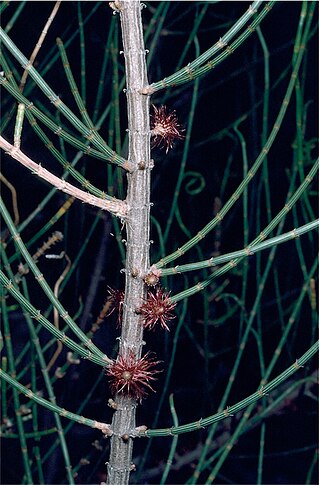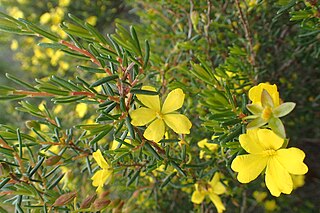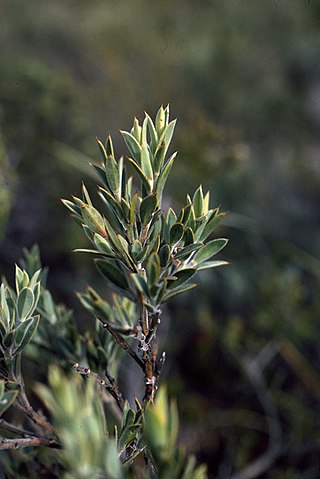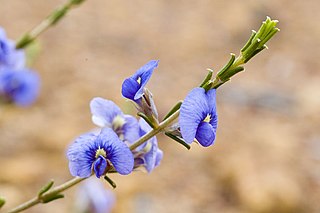
Southwest Australia is a biogeographic region in Western Australia. It includes the Mediterranean-climate area of southwestern Australia, which is home to a diverse and distinctive flora and fauna.

Macrozamia is a genus of around forty species of cycads, family Zamiaceae, all of which are endemic to Australia. Many parts of the plant have been utilised for food and material, most of which is toxic if not processed correctly.

Macrozamia macdonnellii, common name MacDonnell Ranges Cycad, is a species of plant in the family Zamiaceae. It is endemic to the Northern Territory, Australia.

Macrozamia miquelii, is a species of cycad in the plant family Zamiaceae. It is endemic to Queensland and New South Wales in Eastern Australia. Located within sclerophyll forests dominated by eucalyptus trees, the cycad grows on nutrient-poor soils. It is recognised within the Zamiaceae family for its, medium height at 1 m, intermediate size of male and female cones and lighter green leaves compared to other cycads within the plant family of Zamiaceae. The seeds have an orange red sarcotesta which attracts fauna consumption, allowing a mutualistic seed dispersal for the cycad. These seeds are also edible for human consumption if prepared correctly to remove the toxins.

Macrozamia riedlei, commonly known as a zamia or zamia palm, is a species of cycad in the plant family Zamiaceae. It is endemic to southwest Australia and often occurs in jarrah forests. It may only attain a height of half a metre or form an above trunk up to two metres with long arching fronds of a similar length. The giant cones amidst the crown of palm-like fronds contain edible seeds surrounded by red sarcotesta. The seeds are consumed by birds and animals, and can be a favoured part of the human diet when prepared correctly. M. riedlei benefits from a close association with bacteria that fix nitrogen, which also produce substances found throughout the plant that are toxic to some animals when consumed. The species is cultivated for ornamental use in urban and domestic environments.

Kwongan is a plant community found in south-western Western Australia. The name is a Bibulman Aboriginal term of wide geographical use defined by Beard (1976) as
...a type of country ...[that is] sandy and is open without timber-sized trees but with a scrubby vegetation. It consists of plains in an Australian sense of open country rather than in a strict sense of flat country. ... there are two principal plant formations in the kwongan, scrub heath and broombush thicket ... both ... are sclerophyll shrublands and possess a certain unity when contrasted with woodland and forest or steppe and succulent steppe communities.
Calothamnus blepharospermus is a plant in the myrtle family, Myrtaceae and is endemic to the west coast of Western Australia. It is an upright, spreading, bushy shrub with red flowers in summer. It grows in sandy soil in scrubby country called kwongan.

Calothamnus longissimus is a plant in the myrtle family, Myrtaceae and is endemic to the south-west of Western Australia. It is a small, spreading shrub with unusually long, fine leaves and which produces clusters of red flowers in spring.

Phymatocarpus maxwellii is a plant in the myrtle family, Myrtaceae and is endemic to the south-west of Western Australia. It resembles many small species of Melaleuca, mainly differing in the way its anthers are attached at the top of the stamens. In Phymatocarpus they are attached at their base and open at the other end through two slits. It is a shrub with many small heads of pink to purple flowers, often covering the plant for several weeks in October.

Allocasuarina corniculata is a species of flowering plant in the family Casuarinaceae and is endemic to the south-west of Western Australia. It is an erect to spreading, dioecious shrub that has more or less erect branchlets, the leaves reduced to scales in whorls of six to eleven, the mature fruiting cones 8–15 mm (0.31–0.59 in) long containing winged seeds (samaras) 3–4 mm (0.12–0.16 in) long.

Eucalyptus doratoxylon, commonly known as the spearwood mallee, spearwood or geitch-gmunt in Noongar language is a species of mallee that is endemic to Western Australia. It has smooth, powdery white bark, lance-shaped to curved adult leaves mostly arranged in opposite pairs, flower buds in groups of seven, white to pale yellow flowers and pendulous, more or less spherical fruit.
Calytrix creswellii is a species of plant in the myrtle family Myrtaceae that is endemic to Western Australia.
Calytrix decandra, commonly known as the pink starflower, is a species of plant in the myrtle family Myrtaceae that is endemic to Western Australia.
Scholtzia uberiflora is a shrub species in the family Myrtaceae that is endemic to Western Australia.
Olearia revoluta is a species of flowering plant in the family Asteraceae and is endemic to the south-west of Western Australia. It is an erect, rounded shrub with linear to oblong leaves with the edges rolled under, and white daisy-like inflorescences.

Hibbertia subvaginata is a species of flowering plant in the family Dilleniaceae and is endemic to Western Australia. It is a small shrub that has yellow flowers with stamens arranged around three or four carpels.

Hibbertia gracilipes is a species of flowering plant in the family Dilleniaceae and is endemic to the south-west of Western Australia. It is an erect, multi-stemmed shrub that typically grows to a height of 15–60 cm (5.9–23.6 in). It blooms between March and December producing yellow flowers. First formally described in 1863 by George Bentham in Flora Australiensis, the specific epithet (gracilipes) means "thin foot", referring to the peduncles.

Daviesia abnormis is a species of flowering plant in the family Fabaceae and is endemic to the south-west of Western Australia. It is an erect, hairy shrub with sharply-pointed, narrow elliptic to narrow egg-shaped phyllodes with the narrower end towards the base, and yellow flowers with faint red markings.

Mirbelia floribunda, commonly known as purple mirbelia, is a species of flowering plant in the family Fabaceae and is endemic to the south-west of Western Australia. It is an erect, slender or straggling, much-branched shrub with narrowly linear leaves and bluish-purple flowers.

Cryptandra spyridioides is a species of flowering plant in the family Rhamnaceae and is endemic to the south-west of Western Australia. It is a shrub that typically grows to a height of 10–80 cm (3.9–31.5 in) and has green and creamy-white to pink flowers from May to August. It was first formally described in 1862 by Ferdinand von Mueller in his Fragmenta Phytographiae Australiae. The specific epithet (spyridioides) means "sweeper", hence "Spyridium-like".

















